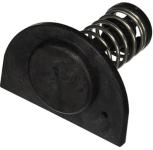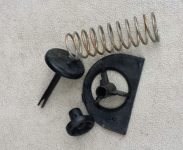I’m working on a heater that repeatedly cycles on and off but still seems to slowly climb in temperature. And it shuts down it’s giving me an HLS error. I replaced the thermal regulator which seemed to have some modest corrosion on it. And now it’s shutting down with an E05 error. Tracking the flue temperature, it will reach about 200° bounce around a little bit, display 40, then bounce up to 200 or so, before shortly shutting down. Pentair tech support indicates it’s likely a flu sensor error. Would that be the consensus on next step to take? Changing the stack flu sensor?
HLS followed by E05
- Thread starter QPSUtah
- Start date
You are using an out of date browser. It may not display this or other websites correctly.
You should upgrade or use an alternative browser.
You should upgrade or use an alternative browser.
E05 Error with SFS Reading 40.
If the SFS reads 80, then flashes to 40, then back to 80, then the 80/40 reading and E05 indicate that the board is not getting a reading from the sensor.Try reseating the connectors on the SFS.
Otherwise, it's a bad sensor or damaged wires.
If the sensor and wiring are good, the board is probably bad.
Disconnect the sensor and check continuity across its terminals.
Resistance should be 3.5-4.0 megohms.
You can get an E05(open sensor) if a rat chews through the wire(s).
If you hold down the "pool on" button, it stays on 80, then flashes to 40, then back to 80, then the 80/40 reading and E05 indicate that the board is not getting a reading from the sensor.
It's usually a bad sensor or damaged wires.
- The high limit switch (HLS), which opens if the heat exchanger outlet temperature goes above 135° F (57° C) and
- .....PS (Pressure Switch)
- .....HLS (High Limit Switch)
- .....SFS (Stack Flue Sensor)
- .....AFS (Air Flow Switch)
- .....AGS (Automatic Gas Shutoff).
- .....Service System
- .....Thermistor
- .....Heating
- .....Pool On
- ...Spa On
- ...Service Heater.
- Thermal regulator not opening.
- External bypass open.
- Internal bypass broken.
- Pump too small or on too low rpm.
- Clogged filter.
- Scale in heat exchanger.
Awesome. As an update, I did replace the stack flue sensor and stuck around for about 20-30 minutes and the heater operated well with the temperature climbing and the stack flue temperature reading in the 300's (371? or 330? I can't recall exactly). However, later that evening I checked the app and the heater had shut off again. I returned this morning and saw a PS error code in the history. The skimmer seems to easily suck air so I closed the skimmer valve and manually turned the spa back to heat mode on the intellicenter display.
Checking the app now, the heater has again shut off. I'll go back this afternoon and check the error code. I assume it will be another PS error code but will confirm.
Also, I confirmed the regulator was not working later by placing in hot water and it did not open, so that was indeed part of the problem.
We have not serviced this pool regularly but have done some occasional work on it and his alkalinity runs very high and his pH has been very high in the past. I wonder if the heat exchanger tubing has a lot of deposits on it from historical use.
What am I looking for exactly regarding the regulator pipe view of the bypass disc and the inlet pipe?
Also, as I'm looking at the app remotely for the pool, not sure if it's a connectivity issue or if the heater is actually cycling on and off, but it will show the heater as idle and a few minutes later will show it as heating. Will the heater generally self correct and try firing up again with a PS error code?
Checking the app now, the heater has again shut off. I'll go back this afternoon and check the error code. I assume it will be another PS error code but will confirm.
Also, I confirmed the regulator was not working later by placing in hot water and it did not open, so that was indeed part of the problem.
We have not serviced this pool regularly but have done some occasional work on it and his alkalinity runs very high and his pH has been very high in the past. I wonder if the heat exchanger tubing has a lot of deposits on it from historical use.
What am I looking for exactly regarding the regulator pipe view of the bypass disc and the inlet pipe?
Also, as I'm looking at the app remotely for the pool, not sure if it's a connectivity issue or if the heater is actually cycling on and off, but it will show the heater as idle and a few minutes later will show it as heating. Will the heater generally self correct and try firing up again with a PS error code?
This is the internal bypass.
You can see the spring in the heater inlet.
You can see the disc in the thermal regulator hole.
It works like a spring check valve.
The disc gets pushed open by water pressure to allow some water to bypass the heat exchanger but the disc can break off and allow too much water to bypass the heat exchanger.





You can see the spring in the heater inlet.
You can see the disc in the thermal regulator hole.
It works like a spring check valve.
The disc gets pushed open by water pressure to allow some water to bypass the heat exchanger but the disc can break off and allow too much water to bypass the heat exchanger.





I get that's the bypass valve, but just making sure I see the spring in there? Indicating it isn't broken and still functioning?
Yes.I get that's the bypass valve, but just making sure I see the spring in there? Indicating it isn't broken and still functioning?
Usually, you can just look in the hole for the thermal regulator to make sure that the disc is still there.
It can break off and go out of the heater outlet.
The red arrow points to the disc.
If the disc is missing, the hole will look like the bottom picture.


Yes.Will the heater generally self correct and try firing up again with a PS error code?
PS is pressure switch.
If the error clears, the heater will try to fire again.
the stack flue temperature reading in the 300's (371? or 330? I can't recall exactly).
Exhaust Gas Temperature.
While running, press and hold the On button to display the exhaust temperature (Older Models).The new models use the Menu to get the SFS.
Here is what the normal exhaust temperature should be:
- Below 250 degrees...very low
- 250 to 290 ..................low
- 290 to 350.................acceptable
- 350 to 480 ..................high
- Above 480...................error/shutdown.
If the exhaust gas temperature is higher than normal, water may bypass the heat exchanger through a broken bypass valve.
If you hold down the "pool on" button, it stays on 80, then flashes to 40, then back to 80, then the 80/40 reading and E05 indicate that the board is not getting a reading from the sensor. It's usually a bad sensor or damaged wires.
Maybe a sticky weir.The skimmer seems to easily suck air
Perfect! Thanks! That's helpful to see the difference. The PS error hasn't come back since I closed the skimmer valve, which again tends to suck air, which is good news.Yes.
Usually, you can just look in the hole for the thermal regulator to make sure that the disc is still there.
It can break off and go out of the heater outlet.
The red arrow points to the disc.
If the disc is missing, the hole will look like the bottom picture.
View attachment 626522
View attachment 626523
You might need to replace the weir or remove it until you can figure out why it is sticking.
Is the water level good?
Is the water level good?
You don't want to operate on just the main drain, especially if there is only one.
It is not safe and you might pop open the hydrostat if the grate gets clogged with debris.
It is not safe and you might pop open the hydrostat if the grate gets clogged with debris.
Okay. Whoever closed his pool did not put any sort of cap in the overflow line between the spa and the pool so the spa level can only get so high before it drains out and at that level, the weir seems to restrict flow too much into the skimmer. I'll put a plug into the overflow line which should allow me to raise the spa level to prevent air getting into the skimmer line.You don't want to operate on just the main drain, especially if there is only one.
It is not safe and you might pop open the hydrostat if the grate gets clogged with debris.
Thread Status
Hello , This thread has been inactive for over 60 days. New postings here are unlikely to be seen or responded to by other members. For better visibility, consider Starting A New Thread.




